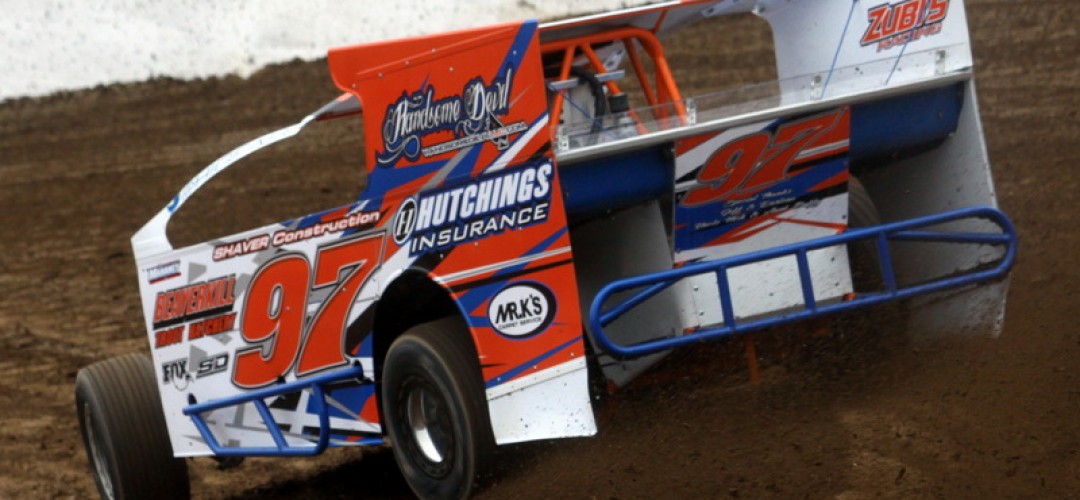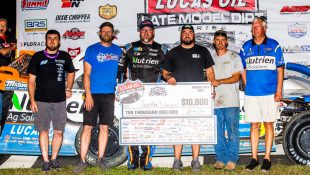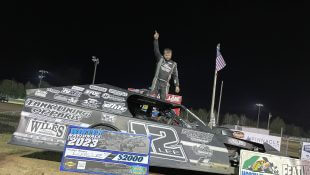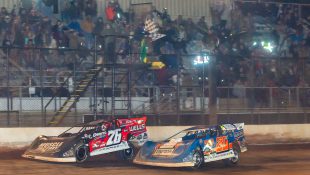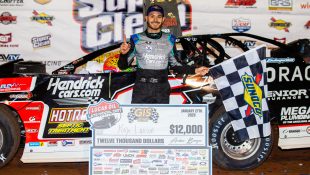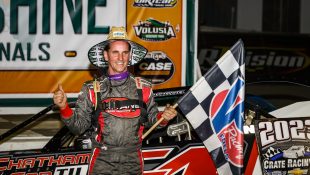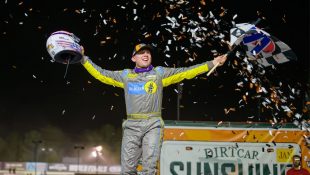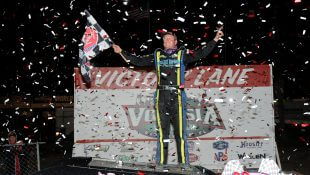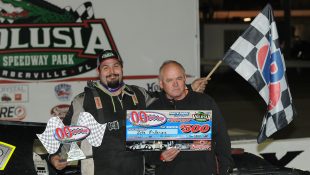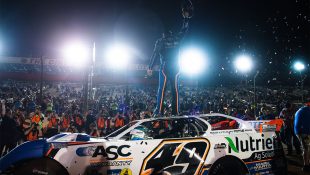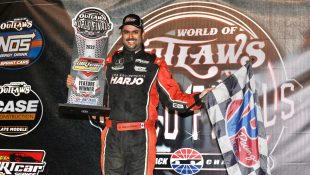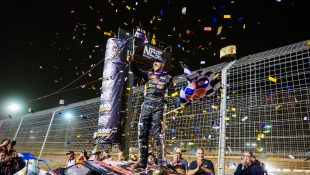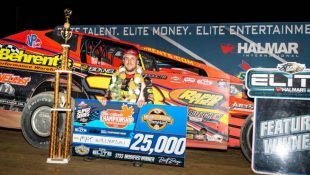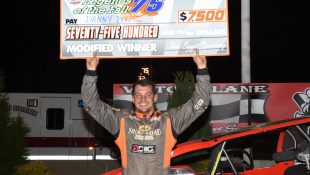[xyz-ihs snippet=”Posts-Ad”]
Established Driver and Respected Chassis Builder Jerry Higbie Looks at the current Racing Climate and what the Future Holds for Dirt Racing in the Northeast
Story By: MATT NOLES / RACERSGUIDE.COM Photos By: DAVE DALESANDRO
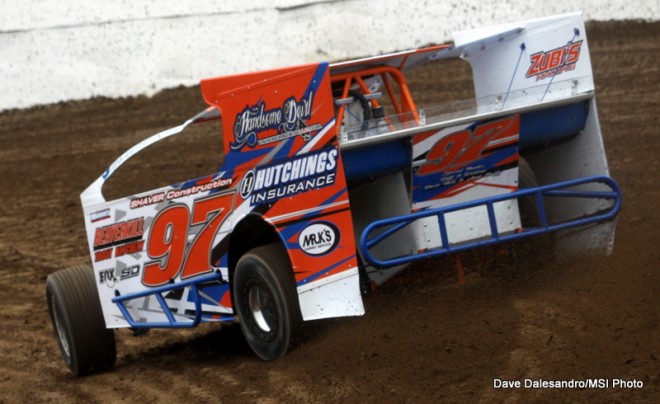 SPRAKERS, NY- January 13, 2016- The gilded age of dirt racing in the northeast was officially over.
SPRAKERS, NY- January 13, 2016- The gilded age of dirt racing in the northeast was officially over.
In the wake of the economic racing boom of the mid 1980s, which transcended from one millennium to the next, the seemingly endless well began to run dry with the ‘Great Recession’ of 2008. After years of phenomenal performance for both the industry and the racers, the wave of good fortune and prosperity came to an immediate and resolute halt by 2010.
Some race teams cut back on their programs while others disappeared altogether. Promoters now had to struggle to fill their pit areas and fans, no longer privy to any form of disposable income, were forced to remove all frivolous expenses from their monthly budget. It seemed that the end, which many of the well-to-do experts had been predicting for eons, was finally at hand.
While some were in agreement that racing in the northeast had finally run its proverbial course, others weren’t as eager to jump on the bandwagon of naysayers and pessimists. Though the decline would certainly cause more harm than many of us would have expected, there were numerous individuals with insider knowledge and years of experience that saw the potential the future could bring. One of these men is the master fabricator and championship caliber driver they call ‘The Statesman;’ Jerry Higbie.
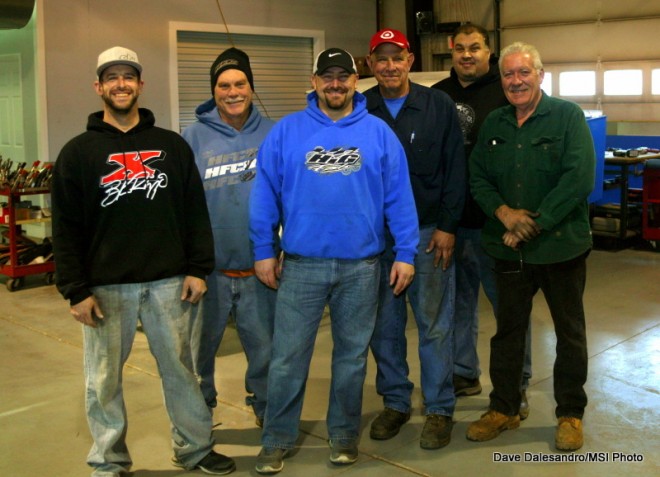 Higbie, the owner of Higbie Fabrication, has seen nearly everything the sport has had to offer for the better part of four decades. Growing up the son of a car owner in the pit area of the Orange County Fair Speedway in Middletown, New York, it’s safe to say he’s as experienced in the rise and decline of the dirt racing cycle as any of his contemporaries.
Higbie, the owner of Higbie Fabrication, has seen nearly everything the sport has had to offer for the better part of four decades. Growing up the son of a car owner in the pit area of the Orange County Fair Speedway in Middletown, New York, it’s safe to say he’s as experienced in the rise and decline of the dirt racing cycle as any of his contemporaries.
“Our racing really hit a low about four or five years ago and it goes hand-in-hand with the economy,” stated Higbie. “I think it’s starting to take an upswing right now but there are still a lot of people who can’t afford to go racing and the cost of it has really taken the sport out of their hands.”
With the founding of crate divisions over the past five years, there has been a desperately needed influx of people coming back to the sport after being forced away due to economic issues. More noticeable than that fact, and more promising as well, is the ‘new blood’ that has been steadily pouring into the pit areas of speedways around the region. However, for the sport to continue to recover cost cutting measures are only part of the formula for success; the other part is a strong and consistent rule package.
“The crate divisions that were developed over the past few years are making it more affordable for a lot of people,” Higbie continued. “I think that if the industry can keep good rules on these divisions then that will be a good future for up and coming racers because what is starting to happen is there is a pretty big difference between what the sportsman teams are spending compared to your high-quality modified teams. It’s becoming a pretty big step and if we’re not careful that step could be too tough for some people to take.”
While some consider this small amount of rejuvenation trivial, Higbie sees something that could become long-standing over the next few seasons. “I do see everybody in the industry growing race wise and I’m starting to see car counts come back a bit,” Higbie stated. “Two years ago it seemed like we all hit an all-time low with car counts and now we’re starting to see those numbers come back. It’s a slow process but it’s starting to happen.”
It isn’t just the current generation of racers that has begun to bounce back after difficult times, it’s the future generation as well. “We’re also seeing kids getting a lot more involved with slingshots and with the rookie sportsman class as well,” Higbie said. “We’re seeing a lot of teenagers getting involved and I really think that if this trend continues, the future of the sport is going to become more secure because of it.”
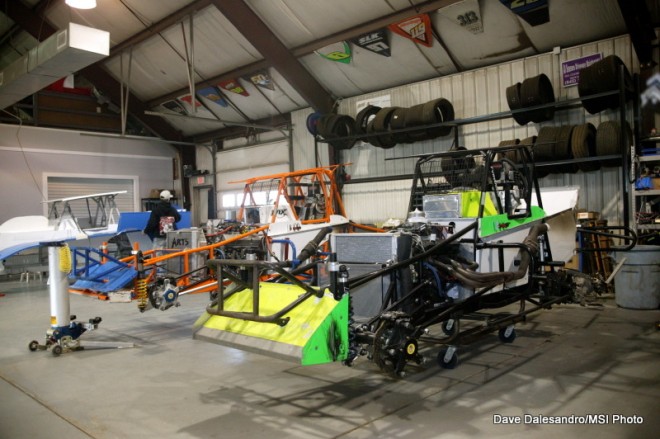 Aside from the fortitude and determination of the individual driver, the renewed interest of large businesses in the sport has also lent a helping hand in the recovery. “We’re also seeing a lot of businesses like Halmar getting involved and helping out the speedways, the drivers and the fans,” remarked Higbie. “There are a lot of talented drivers that are starting to get the chances that they wouldn’t normally get. From the rookie classes all the way to the top modified teams, there really seems to be some new life being breathed into the sport.”
Aside from the fortitude and determination of the individual driver, the renewed interest of large businesses in the sport has also lent a helping hand in the recovery. “We’re also seeing a lot of businesses like Halmar getting involved and helping out the speedways, the drivers and the fans,” remarked Higbie. “There are a lot of talented drivers that are starting to get the chances that they wouldn’t normally get. From the rookie classes all the way to the top modified teams, there really seems to be some new life being breathed into the sport.”
As optimistic as Higbie is, there are still some sounds of caution as he looks towards the future. “You know, we’re seeing this upswing over the past year in all areas,” Higbie stated. “And I keep seeing it a little bit more and a little bit more but it’s going to be tough to tell in the next couple of years what is going to happen. The recovery has to be handled gently and responsibly or we’re going to lose everything that we’ve gotten back.”
For the sport to continue to grow and flourish it will take more than just renewed interest and an influx of money; it will also take the willingness of sanctioning bodies to set aside their differences and begin to work toward the common goal of what is best for sport and not just themselves.
“I still think the sanctioning bodies, and this has been like this forever, need to work hand-in-hand the best they can,” Higbie continued. “They need to try to cater to the racer more than to themselves against the other sanctioning bodies. We can’t be putting good races up against other good races and we can’t be penalizing a guy like Brett Hearn for going to race for money 20 minutes away while missing a race sanctioned by someone else four hours away. They need to take better care of the drivers and leave the petty differences behind.”
Aside from sanctioning bodies leaving their infighting out of the fray, there are other steps that need to be taken to bring the dedicated race fan back to the sport and at the same time, bring new fans to the speedway as well.
“Times are different now and almost every race can be followed online these days so a lot of people don’t even have to go out of their house,” Higbie stated. “We have to find ways to cater to that type of person and to sell our product to those kinds of people. We really need to just keep up with the times I think and it’s a very, very difficult thing to do.”
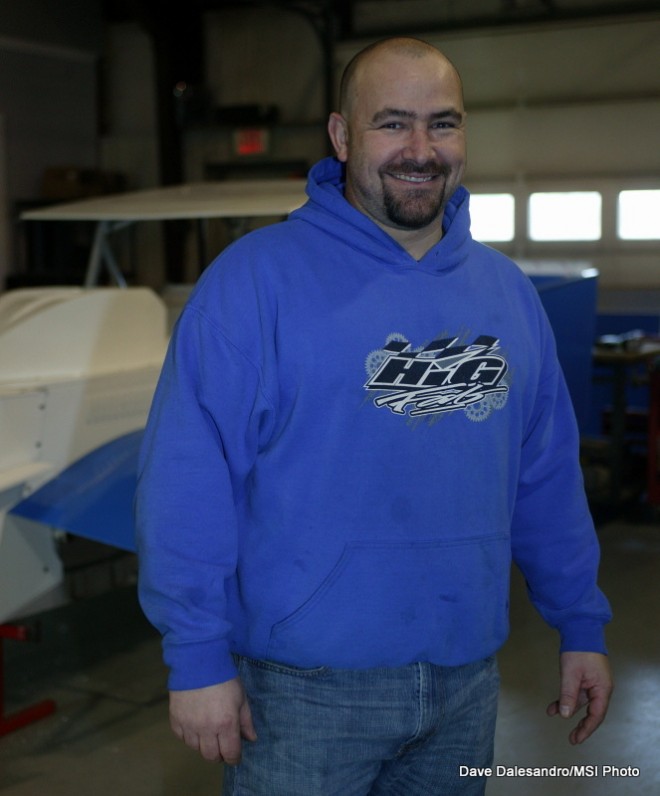 The future of the sport in the next five years looks as bright as ever but as with any economic recovery, it’s more of a journey than a destination. Time, as it often does, will likely tell the tale.
The future of the sport in the next five years looks as bright as ever but as with any economic recovery, it’s more of a journey than a destination. Time, as it often does, will likely tell the tale.
“I think the next four or five years will show a big growth spurt because I do see a lot of young people really getting involved,” continued Higbie. “I think that you’ll see a lot of the numbers from track to track really grow and infuse the whole racing industry with a little bit more money. It’s just going to take some time to get that ball rolling.”
Though Higbie is undoubtedly a businessman, he understands the responsibility he has, he knows where he came from and all of those facts play into his philosophy towards his chassis business; he’s out to make a living, not a killing.
“For me with racing it’s a very, very delicate balance,” stated Higbie. “I know where I came from and I never forget where I came from and I know how difficult racing on a tight budget is so as a result that makes me very partial to the guys who race out of their own pockets and I try to do what I can to help them.”
Regardless of the past or the present, Jerry Higbie has high hopes for the coming years that racing will become better than it was. “I’m hoping that we’ll be able to get more kids and more people involved and out to the track,” Higbie concluded. “Hopefully we can get the sport back to where it was when it was thriving back in the 1980s and at this point if we keep working at it I can definitely see that happening.”
Matt Noles is a contributing writer to Racer’s Guide and Speedway Illustrated. He currently resides in Sprakers, New York.
[xyz-ihs snippet=”Posts-Ad”]

